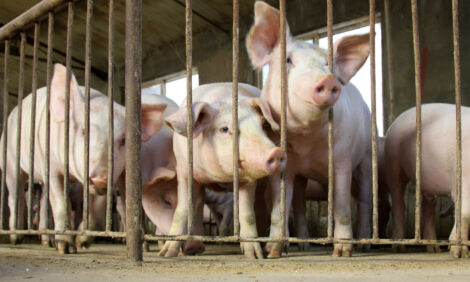



CME: FI US Hog Slaughter Lower Than a Year Ago
US - We have had several inquiries about Friday’s statement that January US pork production was 10.7 per cent lower than one year ago — primarily because that number differs with some readers’ private computations, according to Steve Meyer and Len Steiner.In every case so far it turns out that readers are either using weekly
data or don’t realise that January 2010 had 20 weekdays while January
2009 had 21. Weekly data for this year would have covered the 20
slaughter days but would have compared them to only 20 days last year —
provided one uses that week ending January 9 as the first week of this
year and the week ending 10 January as the first week of last year. That
fits the convention we use — the first week of the year is the week that
includes 4 January. USDA’s Livestock Slaughter publication uses daily
data and that covers only 20 weekdays and 5 Saturdays this year versus 21
and 5, respectively last year.
So the shortfall in days accounts for nearly
5 per cent of the 10.7 per cent decline. That still implies that hog and pork supplies are
considerably lower this year but means that about half of the decline is
likely due to calendar differences. This year contains an unusually large
number of these slaughter day mismatches versus 2009 and market participants
need to make sure they consider these differences as the year progresses. The table below shows the numbers of weekdays and Saturdays in
each month. While six months have different numbers of weekdays, only August will have a different number of Saturdays, which have a much
smaller impact on monthly numbers.

We got many wonderful comments regarding our tribute to Glenn Grimes back in December and thought readers might want to know about
the most recent honor to be bestowed on our friend and colleague. Glenn will be inducted in the US Pork Industry Hall of Fame this Saturday night
during ceremonies at the National Pork Industry Forum in Kansas City. Glenn will be the first economist and only third academician to be included in
this illustrious group. You can drop him a congratulatory note at [email protected]. Congratulations and thanks again, Glenn!
Last week’s estimated federally-inspected (FI) US hog
slaughter was 2.163 million head, only 0.7 per cent lower than one year ago.
That total marks the first time since Christmas week that FI slaughter has
exceeded the level suggested by the market hog inventories of the December
Hogs and Pigs report. The survey for the March report, which
will estimate hog numbers as of today (1 March) hits the field this week.
Year-to-date slaughter keeps inching closer to year-ago numbers but the
YTD total of 17.459 million head is still 6.6 per cent lower than last year and
lower weights leave production 7.2 per cent lower, YTD, than one year ago.
Hog prices 14 to 25 per cent higher than last year should be no surprise in this
supply situation. Demand does not appear to have been a big driver of
this hog rally so far.

FI cattle slaughter continues to run above year-ago levels. Last
week’s 632,000 head was 2 per cent higher than last year. Carcass weights that
were 2.4 per cent lower than last year and negated all of the slaughter increase,
leaving beef production slightly lower than year-ago levels. Fed steer
prices were slightly lower last week but are over 11 per cent higher than last
year at this time.
Finally, it appears that the broiler industry has returned to a
“solid“ expansionary footing. We put solid in quotations due the uncertainty of the Russian situation. Our sources indicate that negotiations between
US and Russian officials will resume this week. The sources expect a resolution which the market seems to expect as well given how leg quarter
prices have held relatively steady. Broiler slaughter, production, egg sets and chick placements were all higher than one year ago this past week.








